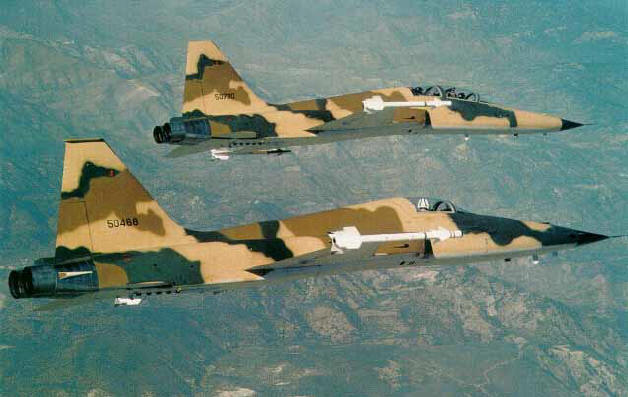|
|
|

|
The
Northrop F-5 was one of the most successful export products of
the US aircraft industry. Although it did not have the
performance of some of its more-costly contemporaries, it was
reliable, easy to maintain, and relatively inexpensive. It
served in relatively small numbers with the United States armed
forces, first as a trial with the USAF in Vietnam and then later
as an adversary aircraft with the USAF, Navy, and Marine Corps.
It was widely exported, sometimes funded under the terms of the
Military Assistance Program (MAP) and sometimes sold
commercially under the terms of Foreign Military Sales (FMS). A
total of 1871 F-5s were built by Northrop, and a further 776
were built under license in Canada, Spain, Switzerland, Korea,
and Taiwan. The F-5 is still an important part of many foreign
air forces.
On April 25, 1962, the Department of
Defense announced that it had chosen the N-156F for its Military
Assistance Program (MAP). America's NATO and SEATO allies would
now be able to acquire a supersonic warplane of world-class
quality at a reasonable cost. The USAF was to act as the
purchasing agency for the program and was put in charge of crew
training. The planes were to carry USAF serial numbers for
record-keeping purposes. On August 9, 1962, the Model N-156F was
given the official designation of F-5A and was given the
official name Freedom Fighter. At the same time, a
two-seat combat trainer version was ordered under the
designation F-5B. It looked a lot like the T-38A, but it was to
retain the full combat capability of the F-5A.
The F-5A is optimized for the
air-to-ground role and has only a very limited air-to-air
capability. In the interest of achieving low cost, the F-5A was
not equipped with a fire-control radar, the weapons being aimed
by a simple optical sight acting in conjunction with a small
Emerson radar ranging set installed in the extreme nose.
The F-5A has very docile handling attributes. It is almost
unspinnable, and exhibits little, if any, wing drop at the
stall. By grouping the two J85 engines so closely together,
Northrop has greatly reduced engine-out asymmetric
effects. Production of the F-5A by Northrop ended in June
of 1972, after 636 examples had been manufactured.
|
|
